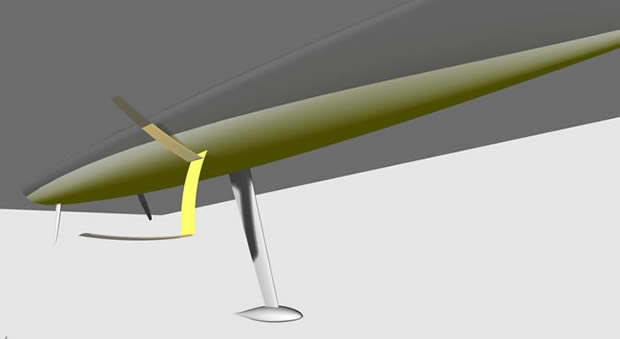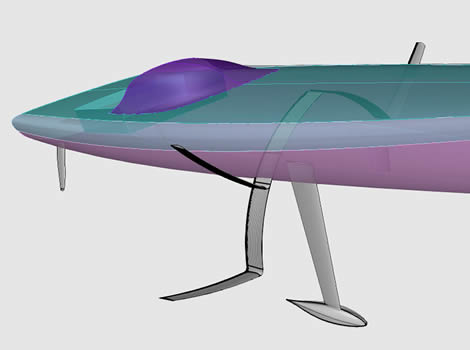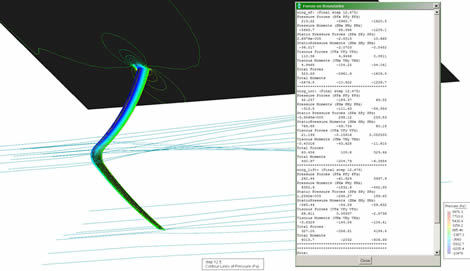DSS foils to revolutionise IMOCA 60 fleet
The sub-text to last week’s decision by IMOCA to place no further restrictions on its class rule is that it will permit both the six new IMOCA 60s currently under construction, as well as the existing fleet, to be fitted with Dynamic Stability System lateral lifting foils (read more about this here).
“These foils will allow IMOCA 60s to remain cutting edge as well as providing a performance enhancement every bit as significant as canting keels, which IMOCA pioneered during the 1990s,” said Dynamic Stability Systems Founder Gordon Kay.
To recap on how DSS works...all yachts require ‘righting moment’ to counter heeling moment from the sails. On most boats this is provided by the keel and its lead bulb. Historically IMOCA 60s have taken this to the maximum, gaining extra righting moment through ultra-beamy hull shapes and canting keels. Created by America’s Cup designer Hugh Welbourn, the Dynamic Stability System (DSS) seeks to replace these features with a retractable foil, protruding laterally from the leeward side of the hull, like an aeroplane wing. This foil produces vertical lift and in turn righting moment, effectively working on the opposite end of the righting moment seesaw from having crew on the rail or a canting keel swung up to weather.
The DSS’s key advantage is that it produces varying amounts of righting moment as required. With the foil deployed, the faster the boat goes through the water, the more lift (and righting moment) it develops, while conversely in light conditions, when it is not required, the foil can simply be stowed by retracting it into the hull to reduce drag.
Fitting DSS to a typical IMOCA 60 is complicated by the class rules which restrict boats to a maximum of five movable appendages – typically two rudders, a canting keel and two daggerboards.
The daggerboards are necessary to prevent leeway when the keel is canted, but on recent IMOCA 60s they have had a dual function as by being inclined in the hull is such a way that they are angled (ie off vertical) as they pass through the water, they also produce upwards lift. This lift helps reduce hull drag, but - most significantly - as it does not operate to leeward of the hull, it lacks the same lever arm and, in turn, the massive contribution to righting moment of the DSS foil. So while present generation IMOCA 60 boards make little contribution to righting moment, for their new boats teams have been investigating the use of more efficient L-shaped foils. With these one side of the foil prevents leeway while the other creates vertical lift down to leeward, in turn providing a massive boost to righting moment.
IMOCA teams have been looking at principally two configurations for these 'DSS L-foils':
a) Tip up: This is similar to a conventional daggerboard only its main shaft is vertical in the water when the boat is heeled, while its tip is effectively a DSS foil, close to horizontal in the water when the boat is heeled, to provide vertical lift.
b) Tip down: This is closer to the standard DSS arrangement where the main shaft of the foil protrudes horizontally through the bottom of the topsides providing vertical lift to leeward, while the downward-pointing tip of the board prevents leeway.
Welbourn, who is currently working with IMOCA teams on evolving this technology, says that while DSS is in the process of being accepted by the Class (just as canting keels were in the 1990s), the first designs to incorporate the DSS L-foils will be ‘middle of the road’ options, still retaining most of the familiar IMOCA 60 features. Thus rather than having the maximum permitted beam of 5.85m, he believes that new DSS L-foil equipped IMOCA 60s will end up closer to 4.8-5.2m.
Cost
DSS L-foils and their cases merely replace conventional daggerboards and their cases, so the only increase in cost comes from the added complexity of building L-shaped foils rather than straight daggerboards. Fortunately alongside the design work carried out on DSS over the last decade, has been R&D into it’s engineering and construction, further progressed by foil development carried out for the flying AC72 catamarans used in the last America’s Cup.
The added cost of the foils is countered through DSS-equipped boats being narrower and thus requiring less materials to go into their build.

The ‘Ultimate’ DSS IMOCA 60
According to Hugh Welbourn, an IMOCA 60 that relied even more on its DSS foil for righting moment would be an entirely different animal but unlike most innovations could represent further cost savings for the Class. The canting keel - along with all its added weight and complexity - could be dispensed with in favour of a simpler fixed keel and as a result there would be no need for additional daggerboards to prevent leeway as the keel foil could provide this (as it does on most yachts). Windward performance could be enhanced by fitting a trim tab to the keel, which is permitted for fixed keels under the present IMOCA rule. This would also allow conventional, straight lateral DSS foils to be fitted, which would be more efficient as their sole functions would be to provide vertical lift and increase righting moment.
Added reliance on the DSS foil would also result in less need for form stability derived from a beamy hull shape and Welbourn envisages the maximum beam of the ‘Ultimate’ DSS IMOCA 60 could be as small as 4.2m – at present the beam constraint is the shroud base required for the newly introduced one design mast, which has a specified size and weight.
A pure-DSS hull shape would also not require the fat bow that features in many modern offshore race boat designs to prevent nose diving when sailing downwind. “When you start supporting a lot of the boat’s displacement on the foil rather than the hull, what you need is something that penetrates waves very nicely at high speed, not a big fat bow. A slimmer type of boat does that,” states Welbourn.
The end result could weigh approximately 6 tonnes, almost two tonnes less than the present lightest IMOCA 60s. And once again, a substantially narrower and lighter boat, with a fixed, rather than a canting, keel and with straight foils, as opposed to L-shaped ones, can all result in a less expensive boat.
Retrofitting IMOCA 60s with DSS
DSS foils or L-foils can also ‘turbo’ the performance of older generation IMOCA 60s. Retrofitting this to an existing boat would cost in the order of £50,000 maintains Welbourn. However this represents good value given that his simulations demonstrate they could take as much as five days off a round the world course compared to the same boat without the new foils.
Welbourn concludes: “Ultimately DSS is a way of producing more sea-kindly and safer boats, which are substantially faster for a negligible increase in cost and potentially with a reduction in cost. Almost all the daggerboards ever fitted to IMOCA 60s provide some degree of vertical lift depending upon their inclination in the boat and the heel angle at the time. DSS foils however are arranged to provide both lift and Righting moment, hence two benefits for the drag cost of one."













Latest Comments
hughw 29/10/2014 - 12:27
I should add here that the configuration shown here is one that happens to work out as the most cost effective solution for this particular older generation design. T foil ends, inward L and J's, outward L's and T's all have their pros and cons - be very interesting to see what does come out eventually - BUT, they are all constrained by IMOCA rules and thats where a 'normal' DSS solution differs when outside of Imoca constraints. Some of those solutions may fall within the boundaries of our DSS patents, some will not - and there are many factors to be considered when deciding on a route to take for an IMOCA legal 60. With several new build projects on the board at the moment we have very different solutions to fit each design's requirements, and none of them will be as shown above!Marion OSM 28/10/2014 - 17:52
Official statement from IMOCA: IMOCA class and appendages – evolution, not revolution At their General Assembly on 15 October, the members of the IMOCA class confirmed the current rule will be maintained thus allowing work to go ahead on boat appendages provided they respect the rule set out in 2013. Since the keels and masts are now one-design under the new rule, designers and engineers predictably are focussing on the appendages. Based on their multihull experience, many of the new projects are working on the introduction of foils or other appendages. It is however a very complex technology and a number of avenues for research are currently being explored. The press release issued about the Dynamic Stability System (DSS) technology and lateral foils aimed at improving the righting moment shows one such possibility. Although the company behind this concept may be dealing with certain IMOCA teams to equip some boats under construction, we know that many other solutions are being investigated. In this respect, IMOCA highlights the fact that no specific technological process has been proven, and that IMOCA’s sole function is to check that the boats conform to the rule. The DSS technology is one of the paths that might be followed, but it is not the only one. Moreover it is part of the beauty of the class that it remains open to innovation and rejects no initiative insofar as it respects the constraints of the rule.Marion OSM 28/10/2014 - 17:50
IMOCA's official statement on their website: http://imoca.azimut.net/en/news/703-imoca-class-and-appendages--evolutio...Add a comment - Members log in